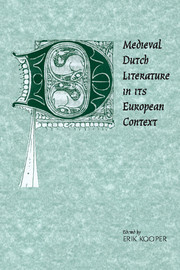Book contents
- Frontmatter
- Contents
- List of contributors
- Preface
- Map
- Introduction
- PART I COURT AND CITY
- 1 Court and city culture in the Low Countries from 1100 to 1530
- 2 Middle Dutch literature at court (with special reference to the court of Holland–Bavaria)
- 3 Heralds, knights and travelling
- 4 The rise of urban literature in the Low Countries
- PART II THE WORLD OF CHIVALRY
- PART III REYNARD THE FOX
- PART IV THE LITERATURE OF LOVE
- PART V RELIGIOUS LITERATURE
- PART VI ARTES TEXTS
- PART VII DRAMA
- Appendix A Bibliography of translations
- Appendix B Chronological table
- Index
4 - The rise of urban literature in the Low Countries
Published online by Cambridge University Press: 13 October 2009
- Frontmatter
- Contents
- List of contributors
- Preface
- Map
- Introduction
- PART I COURT AND CITY
- 1 Court and city culture in the Low Countries from 1100 to 1530
- 2 Middle Dutch literature at court (with special reference to the court of Holland–Bavaria)
- 3 Heralds, knights and travelling
- 4 The rise of urban literature in the Low Countries
- PART II THE WORLD OF CHIVALRY
- PART III REYNARD THE FOX
- PART IV THE LITERATURE OF LOVE
- PART V RELIGIOUS LITERATURE
- PART VI ARTES TEXTS
- PART VII DRAMA
- Appendix A Bibliography of translations
- Appendix B Chronological table
- Index
Summary
In general, late medieval literature of the Low Countries has a poor reputation, and as a result little study is devoted to it. The primary characteristic ascribed to it is burgerlijk (bourgeois or middle-class) which in itself is not incorrect. There can be no doubt that starting in the fourteenth century Brabant and Flanders came to form the hub of literary life, stimulated by the relatively rapid spread of literacy in this area. Literacy grew in response to the special demands of trade and industry, which soon brought the children of well-to-do burghers, and later craftsmen as well, into special city schools for the study of practical subjects. In addition there was rapid growth of a broad intellectual middle class of clerks and officials at work in municipal administration and the judiciary. What emerged from all this was a complex system of guilds and fraternities which became the spawning ground for genuine literary activity, not only because these groups offered possibilities for organization but also because they functioned, together with the city government, as patrons of the literary arts. For literature offered itself as an attractive means to defend, legitimize, ornament and even expand newly acquired power, vested interests and ambitions.
But this is not what those who make condescending remarks about middle-class literature have in mind. The idea behind such statements is that literature as belles-lettres was corrupted by simple-minded didacticism and by dubious forms of entertainment.
- Type
- Chapter
- Information
- Medieval Dutch Literature in its European Context , pp. 62 - 78Publisher: Cambridge University PressPrint publication year: 1994
- 3
- Cited by

